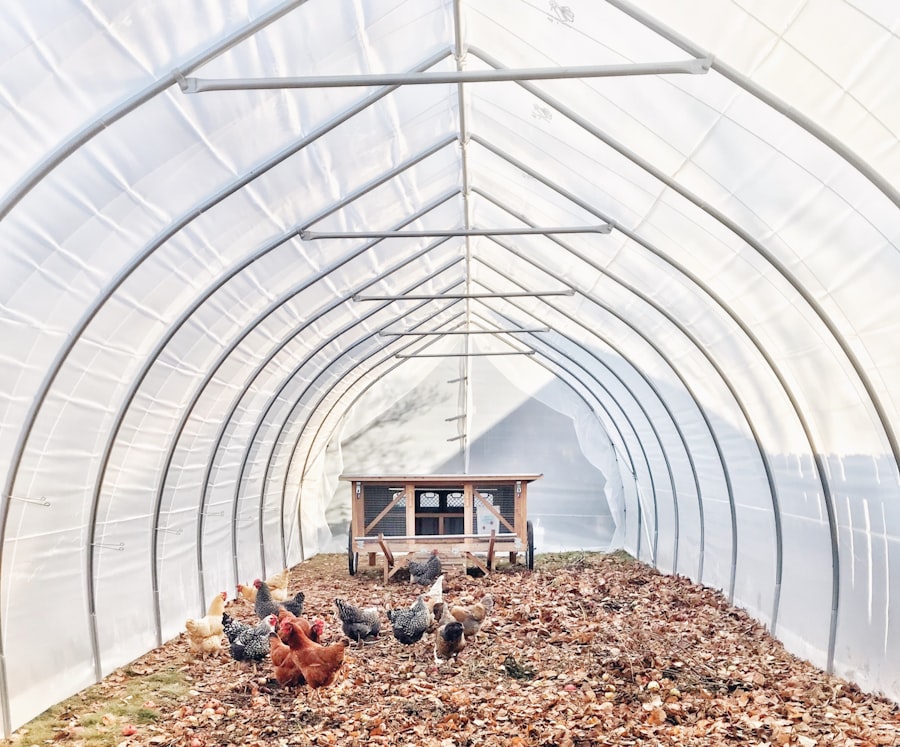Pink slimes are not real creatures and do not pose a threat to chickens or any other animals. This text appears to be fictional or based on a video game or fantasy scenario. In reality, chickens face various challenges from predators and pests, but these are typically foxes, raccoons, rats, or certain insects.
Chicken owners should focus on protecting their flocks from actual threats by using secure coops, proper fencing, and maintaining clean living conditions. It’s important to rely on factual information from reputable sources when caring for livestock or addressing pest control issues in agricultural settings.
Table of Contents
Key Takeaways
- Pink slimes are attracted to chicken coops due to the availability of food and shelter.
- Physical barriers such as fences and netting can be effective in keeping pink slimes away from chickens.
- Natural deterrents like citrus peels and garlic can help repel pink slimes from the coop area.
- A secure chicken coop with strong locks and regular maintenance can prevent pink slimes from entering.
- Providing alternative food sources such as designated feeding areas can help reduce the attraction of pink slimes to the coop.
- Seeking professional advice from pest control experts can provide effective solutions for dealing with pink slimes.
- Regular monitoring and maintenance of protection measures is essential to ensure the continued safety of the chicken coop.
Implementing Physical Barriers to Protect Chickens
Physical Barriers: A Deterrent to Pink Slimes
One effective strategy for protecting chickens from pink slimes is to implement physical barriers that prevent the slimes from accessing the chicken coop. Physical barriers can take many forms, including wire mesh fencing, concrete barriers, and even elevated platforms that make it difficult for pink slimes to reach the coop. These barriers serve as a deterrent to the slimes, making it more challenging for them to access the food and water sources that attract them to the coop in the first place.
Limiting Slime Movement and Reproduction
Additionally, physical barriers can help to limit the movement of pink slimes within the coop, reducing their ability to reproduce and establish a presence in the area. By implementing physical barriers, chicken owners can effectively protect their flock from the threat of pink slimes and create a safe and secure environment for their chickens.
Predator-Proof Fencing: An Additional Layer of Protection
Another effective physical barrier that can be implemented to protect chickens from pink slimes is the use of predator-proof fencing. This type of fencing is designed to keep out not only predators but also unwanted pests such as pink slimes. Predator-proof fencing is typically made of sturdy materials such as metal or heavy-duty wire mesh, making it difficult for pink slimes to penetrate. Additionally, predator-proof fencing is often installed underground to prevent burrowing pests from gaining access to the coop.
Using Natural Deterrents to Keep Pink Slimes Away

In addition to physical barriers, natural deterrents can also be used to keep pink slimes away from chicken coops. Natural deterrents take advantage of the natural instincts and aversions of pink slimes to discourage them from entering the coop. One effective natural deterrent is the use of strong-smelling plants and herbs that are known to repel pink slimes.
Plants such as lavender, mint, and marigold emit strong scents that are unpleasant to pink slimes, making them less likely to approach the coop. Additionally, natural deterrents can also include the use of predator urine or feces, which can create a sense of danger and deter pink slimes from entering the area. By using natural deterrents, chicken owners can effectively keep pink slimes away from their coop without resorting to harmful chemicals or pesticides.
Another natural deterrent that can be used to keep pink slimes away from chicken coops is the introduction of natural predators that feed on pink slimes. Animals such as ducks, geese, and certain species of birds are known to feed on pink slimes, making them effective allies in keeping the pest population under control. By introducing these natural predators into the environment surrounding the coop, chicken owners can create a natural balance that discourages pink slimes from establishing a presence in the area.
Additionally, natural predators can help to reduce the population of pink slimes already present in the coop, creating a safer environment for chickens to thrive. By using natural deterrents such as strong-smelling plants and natural predators, chicken owners can effectively keep pink slimes away from their coop and protect their flock from harm.
Creating a Safe and Secure Chicken Coop
Creating a safe and secure chicken coop is essential in protecting chickens from the threat of pink slimes. A well-designed coop should be constructed with sturdy materials that are resistant to penetration by pests such as pink slimes. Additionally, the coop should be equipped with secure doors and windows that prevent unwanted pests from gaining access to the interior.
It is also important to regularly inspect and maintain the coop to ensure that there are no gaps or openings that could allow pink slimes to enter. By creating a safe and secure chicken coop, chicken owners can effectively protect their flock from the threat of pink slimes and create a healthy environment for their chickens to thrive. In addition to physical security measures, it is also important to maintain good hygiene practices within the chicken coop to deter pink slimes.
Regular cleaning and disinfection of the coop can help to eliminate food sources and breeding grounds for pink slimes, reducing their presence in the area. It is also important to properly store chicken feed and water to prevent attracting pink slimes into the coop. By creating a clean and hygienic environment within the coop, chicken owners can effectively deter pink slimes from establishing a presence and protect their flock from harm.
Providing Alternative Food Sources for Pink Slimes
One effective strategy for protecting chickens from pink slimes is to provide alternative food sources that divert the attention of the pests away from the coop. Pink slimes are attracted to chicken feed and water, so providing alternative food sources can help reduce their presence in the area. For example, setting up feeding stations away from the coop with alternative food sources such as grains or seeds can help distract pink slimes and reduce their reliance on chicken feed.
Additionally, providing access to clean water sources away from the coop can also help reduce the attraction of pink slimes to the area. By providing alternative food sources for pink slimes, chicken owners can effectively reduce their presence in the coop and protect their flock from harm. Another effective strategy for providing alternative food sources for pink slimes is to implement natural pest control methods that target their primary food sources.
For example, introducing beneficial insects such as ladybugs or lacewings into the environment surrounding the coop can help control populations of small insects that serve as food sources for pink slimes. Additionally, implementing natural pest control methods such as diatomaceous earth or nematodes can help reduce populations of small insects that attract pink slimes into the area. By providing alternative food sources for pink slimes and implementing natural pest control methods, chicken owners can effectively reduce their reliance on chicken feed and protect their flock from harm.
Seeking Professional Help and Advice

Expert Knowledge and Experience
Pest control experts have specialized knowledge and experience in dealing with pest infestations and can provide valuable insights into effective strategies for protecting chickens from pink slimes. They can conduct thorough inspections of the coop and surrounding areas to identify potential entry points and breeding grounds for pink slimes.
Targeted Treatments and Solutions
Professional pest control services can provide targeted treatments and solutions that effectively eliminate existing infestations and prevent future infestations from occurring. By seeking professional help and advice, chicken owners can gain access to expert knowledge and resources that can help them effectively protect their flock from the threat of pink slimes.
Additional Resources and Support
In addition to professional pest control services, seeking advice from agricultural extension services or local poultry associations can also provide valuable insights into effective strategies for protecting chickens from pink slimes. These organizations often have resources and information on best practices for pest management in agricultural settings, including strategies specifically tailored for protecting poultry from pests such as pink slimes. By seeking advice from these organizations, chicken owners can gain access to valuable resources and support that can help them effectively protect their flock from harm.
Monitoring and Maintaining the Protection Measures
Once protection measures have been implemented, it is important for chicken owners to regularly monitor and maintain these measures to ensure their effectiveness in protecting chickens from pink slimes. Regular inspections of the coop and surrounding areas can help identify any potential breaches in physical barriers or signs of pest infestation. Additionally, maintaining good hygiene practices within the coop, such as regular cleaning and proper storage of feed and water, can help deter pink slimes from establishing a presence in the area.
By monitoring and maintaining protection measures, chicken owners can ensure that their flock remains safe and protected from the threat of pink slimes. Regular monitoring of protection measures also allows chicken owners to identify any changes in pest behavior or population dynamics that may require adjustments to existing strategies. For example, if there is an increase in pink slime activity near the coop, additional natural deterrents or alternative food sources may need to be implemented to reduce their presence in the area.
By staying vigilant and proactive in monitoring protection measures, chicken owners can effectively adapt their strategies to address changing pest dynamics and ensure continued protection for their flock. In conclusion, protecting chickens from pink slimes requires a comprehensive approach that takes into account the behavior of these pests and implements targeted strategies to deter them from accessing the coop. Understanding the behavior of pink slimes is crucial in developing effective protection measures that disrupt their habitat and reduce their access to food and water sources.
Implementing physical barriers such as predator-proof fencing and natural deterrents such as strong-smelling plants can effectively keep pink slimes away from chicken coops. Creating a safe and secure chicken coop through proper construction and maintenance is essential in protecting chickens from infestations by pink slimes. Providing alternative food sources for pink slimes diverts their attention away from chicken feed and reduces their reliance on it as a food source.
Seeking professional help and advice from pest control experts or agricultural extension services can provide valuable insights into effective strategies for protecting chickens from pink slimes. Finally, monitoring and maintaining protection measures ensures continued effectiveness in protecting chickens from infestations by pink slimes. By implementing these strategies, chicken owners can effectively protect their flock from harm and create a healthy environment for their chickens to thrive.
If you’re looking for a solution to keep pink slimes from eating your chickens, you may want to consider investing in a secure chicken coop. According to a recent article on Poultry Wizard, the Producers Pride Sentinel Chicken Coop is designed to provide maximum protection for your flock. With its sturdy construction and predator-resistant features, this coop can help keep your chickens safe from potential threats like pink slimes. Check out the article here for more information on how to protect your chickens from predators.
FAQs
What are pink slimes?
Pink slimes are a type of slime found in the game “Slime Rancher.” They are pink in color and have a voracious appetite for anything edible.
Do pink slimes eat chickens?
Yes, pink slimes have been known to eat chickens in the game “Slime Rancher.”
How can I keep pink slimes from eating chickens?
To keep pink slimes from eating chickens, you can separate them into different areas of your ranch. You can also use high walls or barriers to keep the pink slimes away from the chickens.
Are there any other methods to prevent pink slimes from eating chickens?
Another method to prevent pink slimes from eating chickens is to feed them regularly with other food sources, such as fruits or vegetables, to keep them satisfied and less likely to go after the chickens.
What happens if pink slimes eat chickens?
If pink slimes eat chickens in the game “Slime Rancher,” it can lead to a decrease in the chicken population on your ranch and potentially affect your gameplay.
Meet Walter, the feathered-friend fanatic of Florida! Nestled in the sunshine state, Walter struts through life with his feathered companions, clucking his way to happiness. With a coop that’s fancier than a five-star hotel, he’s the Don Juan of the chicken world. When he’s not teaching his hens to do the cha-cha, you’ll find him in a heated debate with his prized rooster, Sir Clucks-a-Lot. Walter’s poultry passion is no yolk; he’s the sunny-side-up guy you never knew you needed in your flock of friends!







